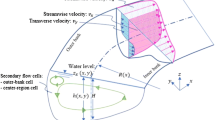Abstract
Nowadays, Autonomous Underwater Vehicles (AUVs) are frequently used for exploring the oceans. The hydrodynamics of AUVs moving in the vicinity of the water surface are significantly different at higher depths. In this paper, the hydrodynamic coefficients of an AUV in non-dimensional depths of 0.75, 1, 1.5, 2, and 4D are obtained for movement close to the free-surface. Reynolds Averaged Navier Stokes Equations (RANS) are discretized using the finite volume approach and the water-surface effects modeled using the Volume of Fraction (VOF) method. As the operating speeds of AUVs are usually low, the boundary layer over them is not fully laminar or fully turbulent, so the effect of boundary layer transition from laminar to turbulent flow was considered in the simulations. Two different turbulence/transition models were used: 1) a full-turbulence model, the k-ε model, and 2) a turbulence/transition model, Menter's Transition-SST model. The results show that the Menter’s Transition-SST model has a better consistency with experimental results. In addition, the wave-making effects of these bodies are studied at different immersion depths in the sea-surface vicinity or at finite depths. It is observed that the relevant pitch moments and lift coefficients are non-zero for these axi-symmetric bodies when they move close to the sea-surface. This is not expected for greater depths.
Similar content being viewed by others
References
Bertram V, 2012. Practical ship hydrodynamics. Elsevier.
Hajmohammadi MR, Nourazar SS, 2014a. On the insertion of a thin gas layer in micro cylindrical Couette flows involving power-law liquids. International Journal of Heat and Mass Transfer, 75(31), 97–108. DOI: 10.1016/j.ijheatmasstransfer.2014.03.065
Hajmohammadi MR, Nourazar SS, Campo A, 2014b. Analytical solution for two-phase flow between two rotating cylinders filled with power law liquid and a micro layer of gas. Journal of Mechanical Science Technology, 28(5), 1849–1854. DOI: 10.1007/s12206-014-0332-y
Hirt CW, Nichols BD, 1981. Volume of fluid (VOF) method for the dynamics of free boundaries. Journal of computational physics. 39(1), 201–25. DOI: 10.1016/0021-9991(81)90145-5
Jagadeesh P, Murali K, 2010. RANS predictions of free surface effects on axisymmetric underwater body. Engineering Applications of Computational Fluid Mechanics, 4(2), 301–313. DOI: 10.1080/19942060.2010.11015318
Jagadeesh P, Murali K, Idichandy VG, 2009. Experimental investigation of hydrodynamic force coefficients over AUV hull form. Journal of Ocean Engineering, 36(1), 113–118. DOI: 10.1016/j.oceaneng.2008.11.008
Lee SK, Joung TH, Cheo SJ, Jang TS, Lee JH, 2011. Evaluation of the added mass for a spheroid-type unmanned underwater vehicle by vertical planar motion mechanism test. International Journal of Naval Architecture and Ocean Engineering, 3(3), 174–180. DOI: 10.2478/IJNAOE-2013-0060
Malavasi S, Guadagnini A, 2007. Interactions between a rectangular cylinder and a free-surface flow. Journal of Fluids and Structures, 23(8), 1137–1148. DOI: 10.1016/j.jfluidstructs.2007.04.002
Malik, SA, Pan G, Liu YA, 2013. Numerical simulations for the prediction of wave forces on underwater vehicle using 3D panel method code. Research Journal of Applied Sciences, Engineering and Technology, 5(21), 5012–5021.
Menter FR, Langtry RB, Likki SR, Suzen YB, Huang PG, V? lker S, 2006. A correlation-based transition model using local variablespart I: model formulation. Journal of Turbomachinery, 128(3), 413–422. DOI: 10.1115/1.2184352
Nematollahi A, Dadvand A, Dawoodian M, 2015. An axisymmetric underwater vehicle-free surface interaction: a numerical study. Journal of Ocean Engineering, 96, 205–214. DOI: 10.1016/j.oceaneng.2014.12.028
Phillips A, Turnock SR, Furlong M, 2010. The use of computational fluid dynamics to aid cost-effective hydrodynamic design of autonomous underwater vehicles. Proceedings of the Institution of Mechanical Engineers, Part M: Journal of Engineering for Maritime Environment, 224(4), 239–254. DOI: 10.1243/14750902JEME199
Rawson KJ, 2001. Basic ship theory. Vol. 1, Butterworth-Heinemann.
Ross A, Fossen TI, Johansen TA, 2004. Identification of underwater vehicle hydrodynamic coefficients using free decay tests. IFAC Conference on Control Applications in Marine Systems, Ancona, Italy.
Shao WY, Zhang YP, Zhu DZ, Zhang TQ, 2013. Drag force on a free surface-piercing yawed circular cylinder in steady flow. Journal of Fluids and Structures, 43, 145–163. DOI: 10.1016/j.jfluidstructs.2013.09.007
Shen YM, Ng CO, Zheng YH, 2004. Simulation of wave propagation over a submerged bar using the VOF method with a two-equation k–e turbulence modeling. Journal of Ocean Engineering, 31(1), 87–95. DOI: 10.1016/S0029-8018(03)00111-2
Taghavi ZR, Salari M, 2006. Prediction of Boundary Layer Transition at High Freestream Turbulence Conditions Using a Physical Model. Aerospace Mechanics Journal, 2(2), 85–95.
Taghavi ZR, Salari M, Etemadi M, 2008. Prediction of laminar, transitional and turbulent flow regimes, based on three-equation k-? turbulence model. Aeronautical Journal, 112(1134), 469–476. DOI: 10.1017/S0001924000002438
Taghavi ZR, Salari M, Kolaei A, 2009. Prediction of boundary layer transition based on modeling of laminar fluctuations using RANS approach. Chinese Journal of Aeronautics, 22(2), 113–120. DOI: 10.1016/S1000-9361(08)60076-X
Tang S, Ura T, Nakatani T, Thornton B, Jiang T, 2009. Estimation of the hydrodynamic coefficients of the complex-shaped autonomous underwater vehicle TUNA-SAND. Journal of Marine Science and Technology, 14(3), 373–386 DOI: 10.1007/s00773-009-0055-4
Tome MF, McKee S, 1994. GENSMAC: A computational marker and cell method for free surface flows in general domains. Journal of Computational Physics, 110(1), 171–186. DOI: 10.1006/jcph.1994.1013
Vorus WS, Paulling JR, 2010. The Principles of Naval Architecture Series.
Willy CJ, 1994. Attitude control of an underwater vehicle subjected to waves. Ph.D thesis, Massachusetts Institute of Technology and Woods Hole Oceanographic Institute.
Zhao M, Cheng L, Zhou T, 2009. Direct numerical simulation of three-dimensional flow past a yawed circular cylinder of infinite length. Journal of Fluids and Structures, 25(5), 831–847. DOI: 10.1016/j.jfluidstructs.2009.02.004
Zhao XZ, Hu CH, Sun ZC, 2010. Numerical simulation of extreme wave generation using VOF method. Journal of Hydrodynamics, Ser. B, 22(4), 466–477. DOI: 10.1016/S1001-6058(09)60078-0
Author information
Authors and Affiliations
Corresponding author
Rights and permissions
About this article
Cite this article
Salari, M., Rava, A. Numerical investigation of hydrodynamic flow over an AUV moving in the water-surface vicinity considering the laminar-turbulent transition. J. Marine. Sci. Appl. 16, 298–304 (2017). https://doi.org/10.1007/s11804-017-1422-x
Received:
Accepted:
Published:
Issue Date:
DOI: https://doi.org/10.1007/s11804-017-1422-x




